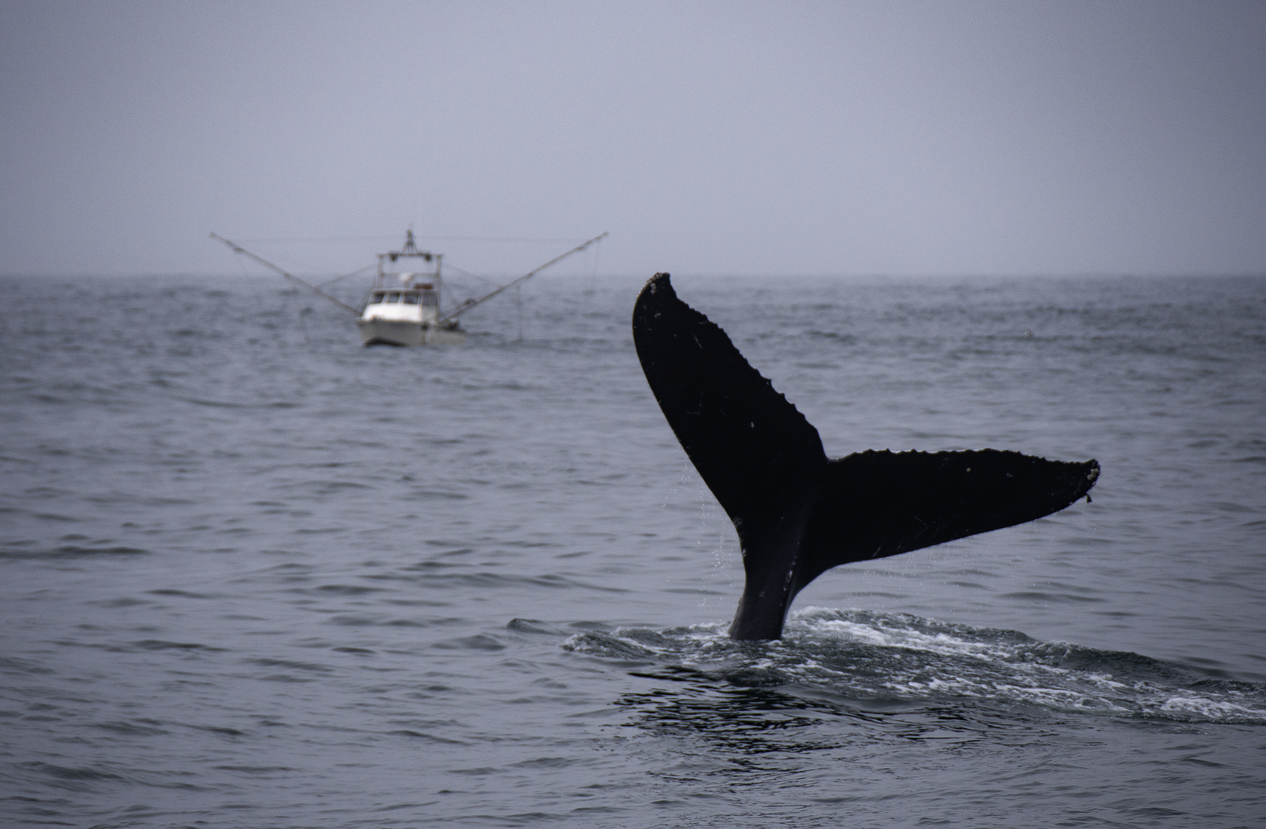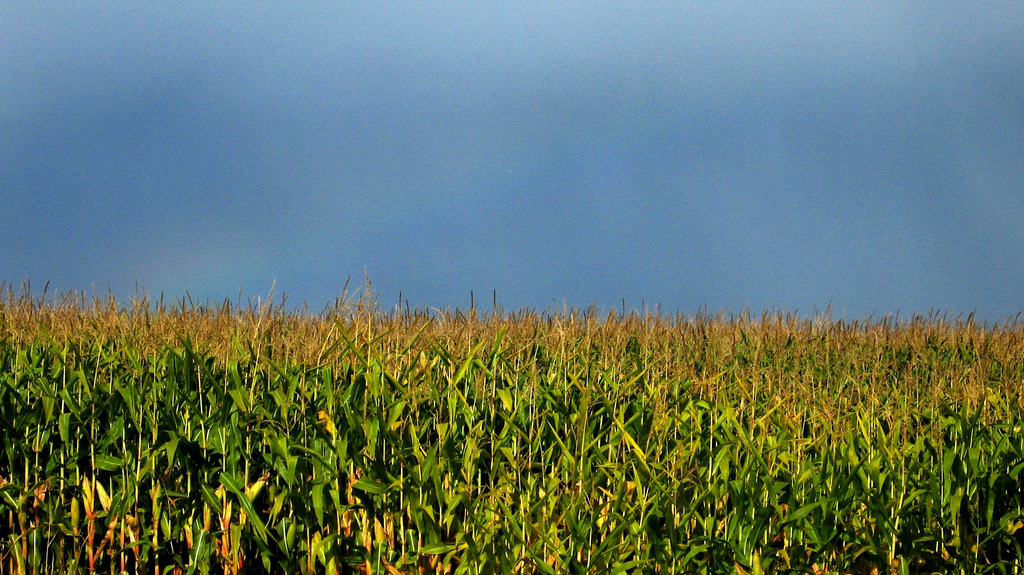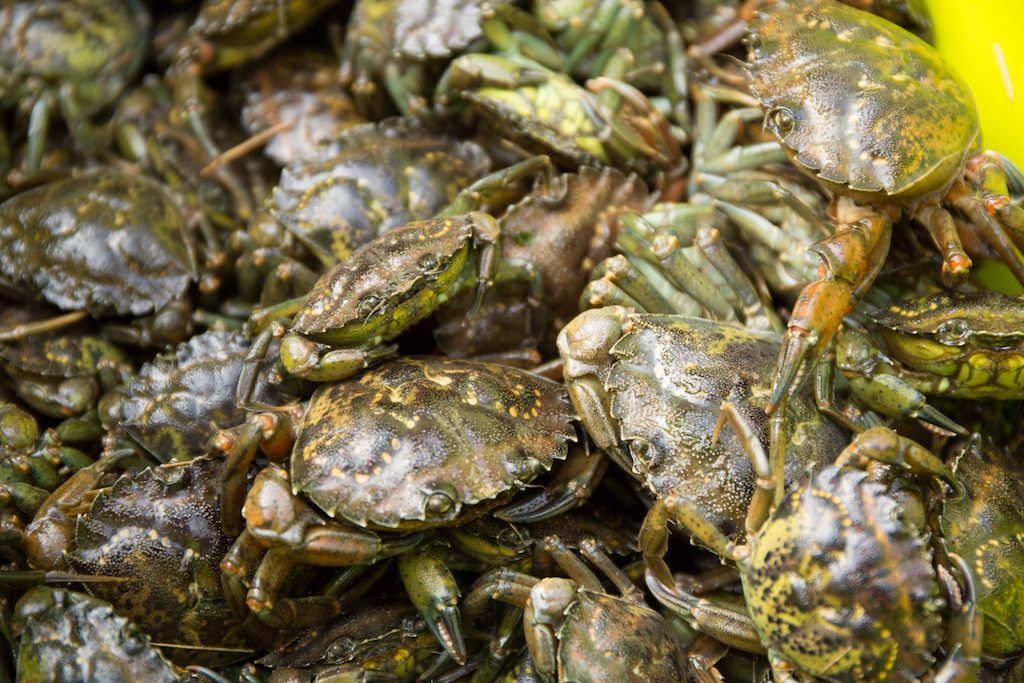
iStock / roclwyr
After decades of whaling decimated their population, humpback whale populations off the West Coast are finally recovering. Hundreds of them now make their way up and down the coast each year, migrating from tropical breeding grounds in Mexico and Central America to feeding areas further north. For the most part, humpback whales—known for their melodic songs, athletic leaps through the air, and altruistic behavior towards other marine mammals—make this journey unhindered, as they did for centuries of their evolutionary history.
But in recent years, a new threat has emerged along the West Coast: From November through mid-July, tens of thousands of deadly ropes hang in the water column, connecting buoys at the surface with crab traps on the seafloor, designed to harvest Metacarcinus magister, aka Dungeness crab.
While Dungeness crab fishing takes place all along the West Coast—bringing in $88 million to 500 or more fishermen—most whales get entangled in California. There, a dedicated group of fishermen, scientists, and others are urgently trying to find solutions to this emergent problem. They’re doing so not only for the whales’ sake, but also for their own: Following a recent lawsuit over whale deaths, the very future of California’s Dungeness crab fishery now depends on avoiding entanglements. Many have pinned their hopes on a novel type of fishing gear: “ropeless gear” which does without perilous ropes hanging through the water. This solution shows promise, but many obstacles stand in the way before this equipment becomes widely used in California.
🦀🦀🦀
Blue whales are occasionally entangled in fishing gear, and fishing ropes are thought to have sawed off the flukes of gray whales in recent years. But for one reason or another, humpbacks show up more frequently in West Coast whale entanglement statistics than any other type of whale. “Pretty much every day I’m in the water, I see at least some that have entanglement scars,” says whale biologist Alisa Schulman-Janiger, a research associate at the Natural History Museum of Los Angeles County.
The Central American humpback whale population, one of two populations to frequent the West Coast, only numbers around 400 individuals. The death of one whale can have a big impact on the overall population—particularly if it’s a breeding female.
 Katarina Zimmer
Katarina Zimmer Reported whale entanglements on the West Coast since 2010, by species, according to the National Oceanic and Atmospheric Administration
The year 2016 saw a record number of entanglements, in part because of warmer waters that stifled the growth of krill, pushing whales closer to shore in pursuit of anchovies, their alternative prey. In addition, a short fishing season forced fishers to meet their quotas quickly. Crab gear caused nearly 20 humpback whale entanglements that year, the vast majority occurring off California’s coast. Whales dragged California crab gear as far south as Los Angeles and as far north as British Columbia.
In 2017, the Tuscon-based Center for Biological Diversity (CBD) sued the State of California’s Department of Fish and Wildlife over the entanglements of humpbacks—as well as blue whales and leatherback sea turtles—all of which are protected under the Endangered Species Act. The CBD, the state’s Department of Fish and Wildlife, and the Pacific Coast Federation of Fishermen’s Associations came to a settlement this March. This forced the state’s crab fishery to close on April 15th, two months earlier than usual, to avoid the whales’ prime migration season. For the next two years, the season will also end early in places where whales tend to cluster in the spring, such as Monterey Bay.
“For a lot of people, that spring fishery was critical,” says John Mellor, a commercial fisherman who docks his boat in San Francisco. “I fished ‘til the end of the crab season—which ends the end of June—pretty much every year of my career because I had to make money all the time. I live in the Bay Area and it’s expensive, and I have a kid in college.” After the closure, he switched to fishing salmon and sablefish—neither of which are nearly as profitable as Dungeness crab.
🦀🦀🦀
Technically, ropeless fishing gear isn’t ropeless at all. It just means that the rope doesn’t hang around in the water column while fishermen wait for crabs to enter the cages, and is instead secured, along with the buoy, to the crab pot on the ocean floor, until it is summoned upwards by fishermen. Different mechanisms, such as acoustic triggers, are then used to bring rope and buoy to the surface so fishermen can collect it. As such, ropeless systems would be more aptly named “pop-up” gear.
 Desert Star Systems
Desert Star Systems Engineers at Desert Star Systems test a prototype for ropeless fishing gear
This is not a new concept. It is currently being tested by snow crab fishermen in the southern Gulf of St. Lawrence in Canada, whose MSC certification—one of the seafood industry’s most important sustainability certifications—was suspended in 2017 for entangling imperiled North Atlantic right whales. In fact, California’s court settlement incentivizes the use of ropeless gear by allowing Dungeness crab fishermen to fish in areas otherwise closed to fishing as of 2021, explains Kristen Monsell, a senior CBD attorney. “California has a real opportunity to be a leader here in getting this type of gear off the shelf and into the water. It’s a great, great step forwards—particularly from the perspective of the whale,” she says.
However, the costs of the ropeless gear can run two to six times higher than what fishermen currently pay for their gear—a major downside to employing it commercially. Fishers also raise important concerns about the technology’s efficiency and usability in fishing, and believe that other management approaches are a better way forward to get fishers back out on the water. Whether ropeless fishing gear succeeds in California and Canada could set the precedent for other fisheries grappling with whale entanglement problems.
“Saving whales isn’t a ‘feel-good’ situation. It is a requirement of a good business and a good sustainable industry,” says Sean Brilliant, a senior conservation biologist of the Canadian Wildlife Federation’s marine program. “Oceanographers have been putting gear on the bottom of the ocean for hundreds of years and retrieving it [without rope]. So it does work—this isn’t science fiction. The difficulty is that it has to be suitable for a commercial fishing operation.”
 Pieter Folkens
Pieter Folkens Entanglements of crab traps on humpbacks from California
Several manufacturers have stepped forward to try and fill that need. For instance, Desert Star Systems, a California-based ocean technology company, has developed the ARC-1 system, where buoy and line are contained in a bag attached to the crab pots, which is released by an acoustic signal that fishermen can trigger from the surface. This has been already successfully used in Australia’s New South Wales rock lobster fishery since 2012. The Fiobuoy, developed by the Australian firm Fiomarine, also uses an acoustic signal but differs in that the fishing line is wound up onto a spool, which then unravels up towards the surface.
Mellor tested both systems last year in the calm waters of San Francisco Bay. Both buoys popped up successfully at the surface. “But I think that that’s a lot different than the conditions you would see in the Pacific Ocean. It gets extremely rough,” he says. For Dick Ogg, a commercial fisherman from Bodega Bay, the trials did not go as well as hoped: The Fiobuoy appeared at the surface, “but it took forever to come up,” he recalls. Desert Star System’s buoy did not surface at all.
Both fishermen, who are part of a working group launched by the state in 2015 to address the entanglement issues, have some fundamental questions about the gear. Without buoys at the surface to see where other fishermen have set their gear, how do they know they’re not piling gear on top of one another? Will it be too bulky to efficiently transport on the back of a boat? What if the buoys and rope attached to the traps get tugged away by the current, causing the traps to wander off on their own across the seafloor, never to be found? And what if they never resurface? If left at the bottom of the ocean, traps become polluting debris, Ogg warns. “We don’t need more ‘stuff’ in the water. We’re trying to keep this fishery clean.”
 Katarina Zimmer
Katarina Zimmer Reported causes of West Coast whale entanglements since 2010, according to the National Oceanic and Atmospheric Administration
He also worries about the amount of additional time it’ll take to wait for the pots to surface, stuff the rope back into the bag, and drop it into the water again. “If I add one minute to each pot per day, that’s six hours, and for me to tell my crew, ‘Guess what guys? You’re gonna get paid the same amount of money but it’s going to take you six and half hours longer to pull the gear out,’ I think I’d have a mutiny,” he jokes.
Though Canadian snow crab fishermen are experiencing similar hitches, Brilliant says they’re finding overall success with ropeless gear, having trialed several different types so far. He’s optimistic that the systems will eventually be refined enough to work in particular areas. “If everything lines up, it could be within the next five years that we have some ropeless commercial fishing going on here in Canada,” he says.
The biggest concern fishermen raise about ropeless systems is their extraordinary cost. Ogg pays around $250 each for the traps he’s currently using, while estimates for ropeless gear soar into the thousands of dollars. The ARC-1 costs $1550 apiece when purchased in quantities of 100 or more, but Desert Star Systems is developing on other versions that will be priced at around $500, according to Marco Flagg, the company’s CEO and founder. But even $500 per pot would be too expensive for Ogg, who has a permit for 350 crab traps. He reckons it would amount to an additional cost of $87,500 dollars.
Flagg thinks the main economic difficulty with the Dungeness crab fishery is that all pots are secured on individual lines. Joining multiple traps with a ground rope, as is done in Eastern Canada’s lobster fishery, would mean the fishermen only need one or two release devices. This makes the situation more cost-efficient, he suggests.
 Desert Star Systems
Desert Star Systems In the ARC-1 system, buoy and line are contained in a bag attached to crab or lobster traps, and are summoned to the surface through an acoustic signal
If the costs for fishing gear increase, that’ll have knock-on effects for consumers, notes Dante Serafini, who owns the Crab House, a restaurant on Pier 39 in San Francisco known for roasting Dungeness crab in a garlic sauce. With the early closure this year, they’ve had to buy live crabs imported from Canada and Alaska, which cost as much as $9.50 per pound, compared to the usual $6.50—$7.50 per pound. Consumers might balk at the costs of local Dungeness crab if they become excessive due to ropeless gear, he writes in an email. “There’s a certain [price] level at which the crab-buying public is willing to go, but I don’t think they’re willing to double the cost of their crab,” adds Pieter Folkens, one of California’s three primary whale disentanglers—the only people in the state authorized to cut an entangled animal free. (If you want to know more about this fascinating profession, check out this account of a Canadian disentangler giving his life to the profession.)
🦀🦀🦀
There are other technological solutions, although none of them come without issues. For instance, Galvanic Timed Releases—which release buoy and rope to the surface automatically at a specified time—ranked first among other solutions in an analysis by University of Washington researchers. But Mellor points out this would be impractical, say, if the gear pops up on a day where fishermen can’t go out due to bad weather, and were to drift off on its own. Line-cutting devices that automatically sever the fishing line once a certain amount of pressure is applied could theoretically allow whales to untangle themselves. However, some scientists have doubts about their effectiveness, Monsell says.
This includes, for instance, discouraging the amount of excess line floating at the surface, and avoiding setting one’s gear when whales are around. “I calculated that fishermen throughout the State of California across the board invested about 20 million dollars in new fishing gear based on the new best practices recommendations and then new regulations that fishermen had,” says Noah Oppenheim, executive director of the Pacific Coast Federation of Fishermen’s Associations. “I think pop-up gear is a distraction right now and we need to be focusing on the management side and other more readily available, less extraordinarily expensive technical solutions,” he says.
Folkens, who is also part of the working group, believes these “best practices” have led to the drop in whale entanglements since the 2016 entanglement season, which many consider an anomaly: The fishery opened late because crabs became contaminated with domoic acid—a neurotoxin that makes them inedible—so fishermen rushed to meet their annual quota in just one month. Meanwhile, unusually high water temperatures brought whales closer to shore, into the vicinity of crab fishing gear.
Around 10 whale entanglements have been reported in California this year, some of which may have involved Dungeness crab gear from California and Washington state, Folkens says. And according to a risk assessment system the working group has developed to evaluate whether to close or open the fishery, based on fishing intensity, concentration of whales, and ocean conditions, “the fishermen perhaps could have been fishing just fine for April, May and June. It’s only right now—the middle of July—the anchovies have started filling up and the whales are starting to come in later to shore,” Folkens says.
 Desert Star Systems
Desert Star Systems Testing the ropeless gear developed by Desert Star Systems at sea. The technology was used for the first time in Australia’s New South Wales rock lobster fishery
The effort the fishing community has already put into avoiding whale entanglements is one reason why many fishermen were caught off guard by the settlement, particularly as the working group wasn’t consulted in the legal process, according to Mellor. Some also feel the Dungeness crab fishery has been unfairly singled out by the lawsuit, pointing out that whales also become entangled in other fishing gear in the area, such as gill nets. “There’s definitely some bitterness to that, but on the other hand, I think it’s a wake-up call to the fleet that we need to unify and take this a lot more seriously than we had,” says Mellor.
Right now, whale watchers are seeing record numbers of humpbacks breaching and feeding around Monterey Bay, according to Schulman-Janiger. Whether fishermen will continue to join them in future seasons, and what they will have to do to get there, remains to be seen.
“The environmental community needs to understand this: if we get it wrong, it’s make-or-break for fishing communities. These are small-scale fishermen and women who feed them, they’re their neighbors. They are the ones who are the stewards of the ocean. They are the ones working to protect the coastal ocean resources that we all depend on and cherish,” says Oppenheim, noting that in 2017 the fishery even took 30 fossil fuel companies to court for knowingly causing climate change, which is believed to have caused the domoic acid outbreak in the first place. As for addressing the whale entanglements, “We will get there … but it’s going to require a lot of hard work, a lot of patience.”










